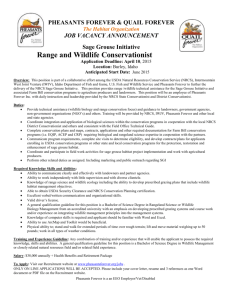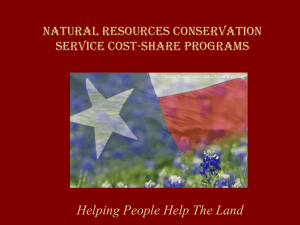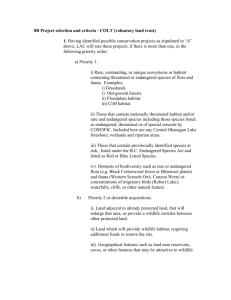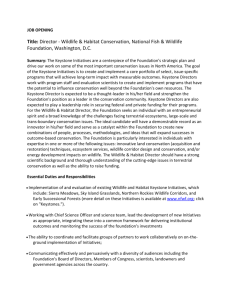Private Landowner Technical Assistance Program Targeted Wildlife
advertisement
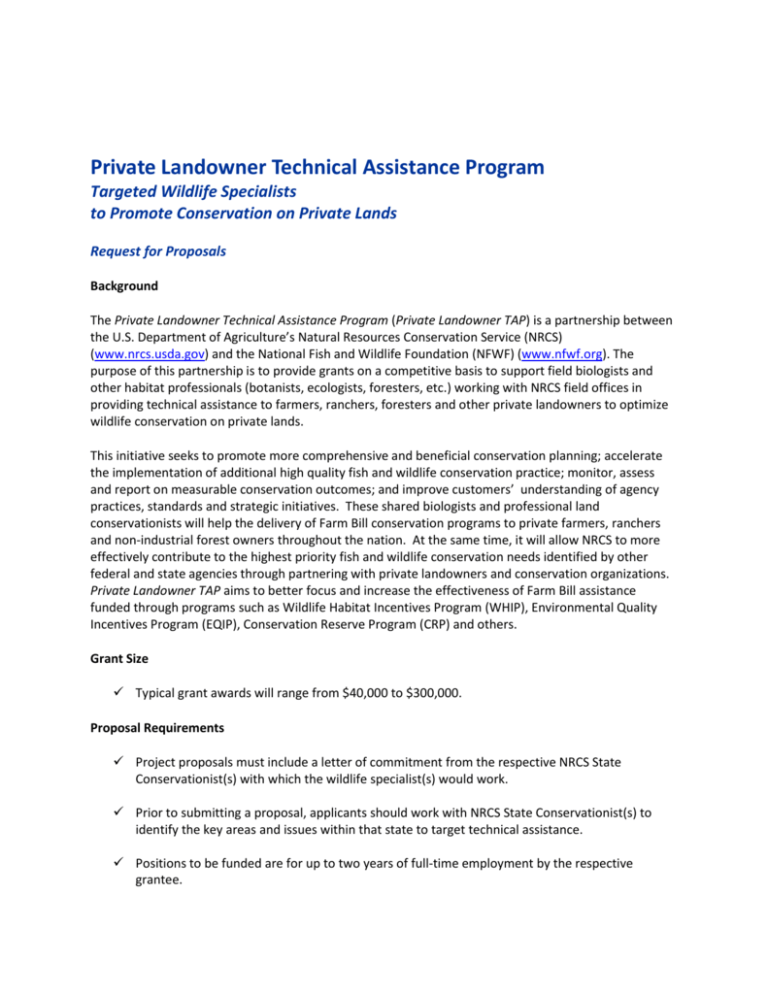
Private Landowner Technical Assistance Program Targeted Wildlife Specialists to Promote Conservation on Private Lands Request for Proposals Background The Private Landowner Technical Assistance Program (Private Landowner TAP) is a partnership between the U.S. Department of Agriculture’s Natural Resources Conservation Service (NRCS) (www.nrcs.usda.gov) and the National Fish and Wildlife Foundation (NFWF) (www.nfwf.org). The purpose of this partnership is to provide grants on a competitive basis to support field biologists and other habitat professionals (botanists, ecologists, foresters, etc.) working with NRCS field offices in providing technical assistance to farmers, ranchers, foresters and other private landowners to optimize wildlife conservation on private lands. This initiative seeks to promote more comprehensive and beneficial conservation planning; accelerate the implementation of additional high quality fish and wildlife conservation practice; monitor, assess and report on measurable conservation outcomes; and improve customers’ understanding of agency practices, standards and strategic initiatives. These shared biologists and professional land conservationists will help the delivery of Farm Bill conservation programs to private farmers, ranchers and non-industrial forest owners throughout the nation. At the same time, it will allow NRCS to more effectively contribute to the highest priority fish and wildlife conservation needs identified by other federal and state agencies through partnering with private landowners and conservation organizations. Private Landowner TAP aims to better focus and increase the effectiveness of Farm Bill assistance funded through programs such as Wildlife Habitat Incentives Program (WHIP), Environmental Quality Incentives Program (EQIP), Conservation Reserve Program (CRP) and others. Grant Size Typical grant awards will range from $40,000 to $300,000. Proposal Requirements Project proposals must include a letter of commitment from the respective NRCS State Conservationist(s) with which the wildlife specialist(s) would work. Prior to submitting a proposal, applicants should work with NRCS State Conservationist(s) to identify the key areas and issues within that state to target technical assistance. Positions to be funded are for up to two years of full-time employment by the respective grantee. Grantees will be required to identify performance and conservation targets, consistent with NRCS’s needs, against which progress will be measured and reported to NFWF. A match of at least 25% non-federal cash or in-kind is required, but larger match ratios are encouraged. Applicant Eligibility Eligible applicants include: non-profit 501(c) organizations, educational institutions, tribes, and state or local units of governments (e.g. state conservation agencies, counties, townships, cities, conservation districts, utility districts, drainage districts, etc.). Individuals, federal government agencies and for-profit firms are not eligible for grants under this program. Funding Priorities Priority for funding will be directed to proposals that target species and ecosystems of shared interest between NFWF and NRCS, including but not limited to the following: (A map of priority project regions can be accessed by clicking here.) Southeastern Longleaf Pine Forests – Longleaf Pine ecosystems once dominated the southeastern United States. Today, conversion to short-rotation pine plantations, fire suppression and development have decimated this ecosystem. This grant program will fund technical assistance for restoration projects throughout the longleaf pine’s historic range, with a particular focus on work in Florida, Georgia, Mississippi and Alabama. Funding will focus on technical assistance needed to support efforts to maintain, recover and restore the longleaf pine ecosystem across its historic range. Chesapeake Bay Watershed – The Chesapeake Bay is one of the nation’s most important and yet degraded major water bodies. This initiative seeks to build upon new strategies prepared by federal and state agencies to restore the Bay by improving stewardship on private lands. Funds will be focused on technical assistance toward projects that accelerate local implementation of the most innovative, sustainable and cost-effective strategies to restore and protect water quality and vital habitats within the Chesapeake Bay watershed, with a particular focus on technical assistance for projects that help restore habitat for eastern brook trout. Short-Grass Prairie – The lesser prairie chicken is in dramatic decline, and it requires pronounced actions to reverse population losses through habitat-based investments. Focusing on short-grass prairie restoration in the eastern regions of New Mexico and Colorado, and the western regions of Kansas, Oklahoma, and Texas will benefit the lesser prairie chicken and hundreds of species of birds which utilize this habitat. Wildlife professionals will provide the technical guidance and support needed by private ranchers to create core habitat areas, and corridors to connect those necessary to recover the lesser prairie chicken and related species. Early Successional Forest Habitat – Declining early successional habitat has been identified as a top priority of all State Wildlife Action Plans in the Northeast and Appalachian regions. Among the species most significantly impacted by this decline are New England cottontail and golden- winged warbler. Private Landowner TAP is interested in supporting efforts to restore early successional habitat with a particular focus on New England and the Appalachian region of eastern Tennessee, Kentucky, Ohio, the state of West Virginia and western Pennsylvania and Virginia. Applicants should describe how their actions in restoring or protecting early successional habitat will benefit the New England cottontail and/or golden-winged warbler. Gulf Coast – Coastal marshlands have experienced decades of depletion. Now, following the Deepwater Horizon oil spill, wildlife dependent upon these coastlands are more impacted than ever. Wildlife professionals are needed to create and restore aquatic and wetland habitat for migratory birds. Concentrated efforts during the past year, demonstrated that waterfowl and other migratory birds will utilize farmland that has been flooded for the fall and/or spring migration. Similar efforts, along with coastal marshland restoration, will be considered for funding under the Private Landowner TAP program. Criteria for Competitive Proposals Proposals will be more competitive if they include: Activities that help conserve the species, habitats and ecosystems in the conservation priorities listed above Measurable conservation outcomes linked to project activities (e.g., target bird population increases by X%) Activities that advance the goals of the NRCS and/or of established regional, State and Federal conservation plans Restoration/protection of habitats/species in, or adjacent to, protected areas Provisions for long-term management, maintenance and protection, as appropriate Documentation of knowledge and experience with the NRCS planning process (For those with limited experience, more information can be found here: http://techreg.usda.gov/Training.aspx) Proven capability in working successfully with private landowners Provide additional matching contributions greater than the minimum of 25% Matching Contributions All grantees are required to provide a minimum 25% match of cash, contributed goods and services from non-Federal sources and/or a mixture of both. The ratio of matching funds offered by the applicant is one criterion considered during the review process. Matching funds may include cash, in-kind contributions of staff and volunteer time, work performed, materials and services donated, or other tangible contributions to the project objectives and outcomes. To be eligible, matching contributions must be: Dedicated specifically for the project Spent between the project start and end dates designated in the grant application Voluntary in nature (mitigation, restitution, or other permit or court-ordered settlements are ineligible) Applied only to the Private Landowner TAP grant and not to any other federal matching programs. Project Duration Projects should be completed within 2½ years following receipt of a grant agreement; each position will be funded up to 2 years. Project start and end dates should define the period during which all proposed work is accomplished, all requested funds are spent, and all matching funds are spent. A grant may support one part of a larger, longer project with multiple stages; that part of the project supported by the grant must be completed within the specified time frame. Ineligible Uses of Funds Funds granted under this program may not be used to support political advocacy, lobbying or litigation. Grantees may not use grant funds to support ongoing efforts to comply with legal requirements (e.g., permit conditions, mitigation, settlement agreements) of any local, state or federal permit. Grant funds may be used to support projects that enhance or improve upon existing baseline compliance efforts. Grantees may only use grant funds for indirect costs if they meet the following conditions: o the grantee organization has a federally-approved indirect rate; and, o indirect costs do not exceed 15% of the total grant request (even when the federallyapproved rate is greater than 15%). Deadlines and Application Procedures Proposals are due on February 15th, 2011. A webinar to review the grant process, program goals and answer questions will be held on January 24th, 2011 from 11:00 am - 12:00 pm, EST. All application materials must be submitted online through National Fish and Wildlife Foundation’s Easygrants system. Hard-copy applications will not be considered for funding. To start an application, please click on the following link: http://www.nfwf.org/easygrants. New users to the system will be prompted to register before starting their application. Applications may be saved and returned to at a later time for completion and submission, up until the application deadline. It is imperative for Easygrants users to disable their browser’s pop-up blocker prior to beginning the application process. Grants are anticipated to be announced the week of April 4th, 2011. The following link contains access to other useful information for applicants, including videos that demonstrate the Easygrants online system: http://www.nfwf.org/applicantinfo. Prospective applicants may contact John Curry (john.curry@nfwf.org; 612-713-5176) before submitting a proposal. Related Files Back to Program Home View the Private Landowner TAP Map (Adobe PDF File)

